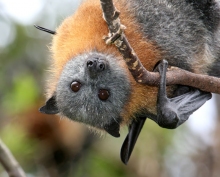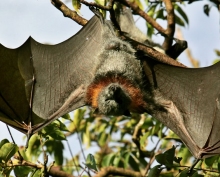Grey-headed flying-fox
- Sydney’s best known bat
- Can migrate 1000 km (read more about their nomadic range)
- From Bundaberg to Melbourne they are one breeding population
- 30% decline in their population was observed in just 10 years (1990 – 2000)
- Listed as a threatened species (category “vulnerable”) by two scientific committees
What do they look like?
- Fur on their heads is grey (more or less)
- Faces can be almost white
- Body fur varies from silver grey to black and is soft
- A mantle of orange fur encircles their necks
- Fur to their knees distinguishes them from other flying-fox species
Airborne
- Their wings can carry them 20 – 24 km per hour
- Flying-foxes can use tail winds to move at speeds up to 60km per hour
- Mostly nightly foraging is within 20km of camp (read more about foraging and feeding habits)
- Satellite tracking has shown some individuals to travel 24,000km in a year, visiting many camps along the east coast of Australia (read more about the movement of grey-headed flying-foxes)
Bat Chat
- Flying-foxes have between 20 and 40 different vocalisations
- Theyspend their days in camp sleeping, grooming and interacting with their neighbours
- Read more about flying-fox vocalisations and hear or download bat soundscapes

